Santen Pharmaceutical Bundle
Who Really Controls Santen Pharmaceutical?
Unraveling the ownership of Santen Pharmaceutical SWOT Analysis is key to understanding its strategic maneuvers and its place in the competitive world of pharmaceuticals. Recent share buyback programs, particularly those announced in late 2024 and early 2025, offer a glimpse into the company's evolving financial strategy. This analysis will explore the intricate web of Santen ownership, providing valuable insights for investors and industry observers alike.
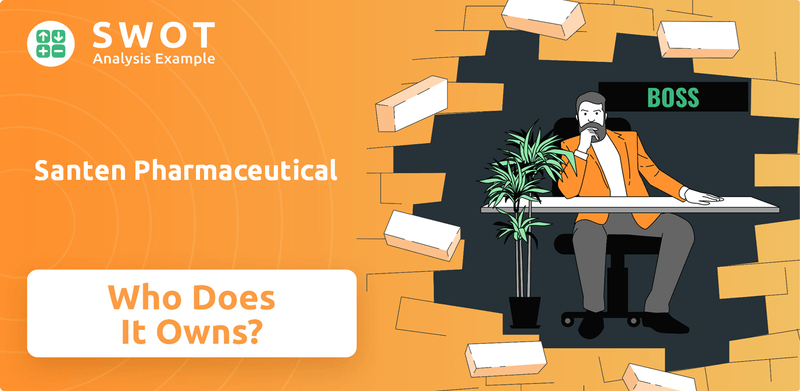
From its origins in 1890, founded by Kenkichi Taguchi, to its current status as a global leader in ophthalmology, understanding who owns Santen is essential. This exploration will navigate the shifts in Santen ownership, from its early backers to its current major shareholders, offering a comprehensive view of this significant Japanese pharmaceutical company. Learn about the company's market capitalization, its board of directors, and how recent financial activities are shaping its future. Knowing the Santen ownership structure is crucial for anyone interested in the pharmaceutical industry.
Who Founded Santen Pharmaceutical?
The story of Santen Pharmaceutical began in 1890, when Kenkichi Taguchi established Taguchi Santendo, a private firm in Osaka, Japan. Initially, the company focused on a cold medication called Heburin-gan. However, recognizing the need for eye care products, Santen quickly pivoted to ophthalmic solutions, launching 'Daigaku Eye Drops' in 1899, which proved highly successful.
In 1914, the firm transitioned into a limited partnership, with Chuko Mita joining as a business partner. Mita later became the first president when Santendo Co., Ltd. was officially established in 1925. This marked a significant step in formalizing the company's structure and setting the stage for its future growth. The early focus on eye care products reflected the founders' vision to contribute to health, particularly in the area of ophthalmology.
While specific details about early ownership structures and shareholding percentages from the initial period are not readily available in public records, the transition to a limited partnership and then a limited company suggests a structured ownership arrangement with Taguchi and Mita as key figures. Early angel investors or family members who acquired stakes during this phase are not publicly documented. For more details, you can read Brief History of Santen Pharmaceutical.
Early ownership of Santen Pharmaceutical was centered on its founders, Kenkichi Taguchi and Chuko Mita. The company's evolution from a private firm to a limited partnership and then a limited company laid the foundation for its corporate structure.
- The company's initial focus on eye care, starting with 'Daigaku Eye Drops', was a pivotal factor in its early success.
- Public records from the early period do not provide detailed information on specific equity splits or shareholding percentages.
- The early strategic direction of the company was clearly influenced by the founders' vision to contribute to health, particularly in eye care.
- The company's headquarters is located in Osaka, Japan.
Santen Pharmaceutical SWOT Analysis
- Complete SWOT Breakdown
- Fully Customizable
- Editable in Excel & Word
- Professional Formatting
- Investor-Ready Format
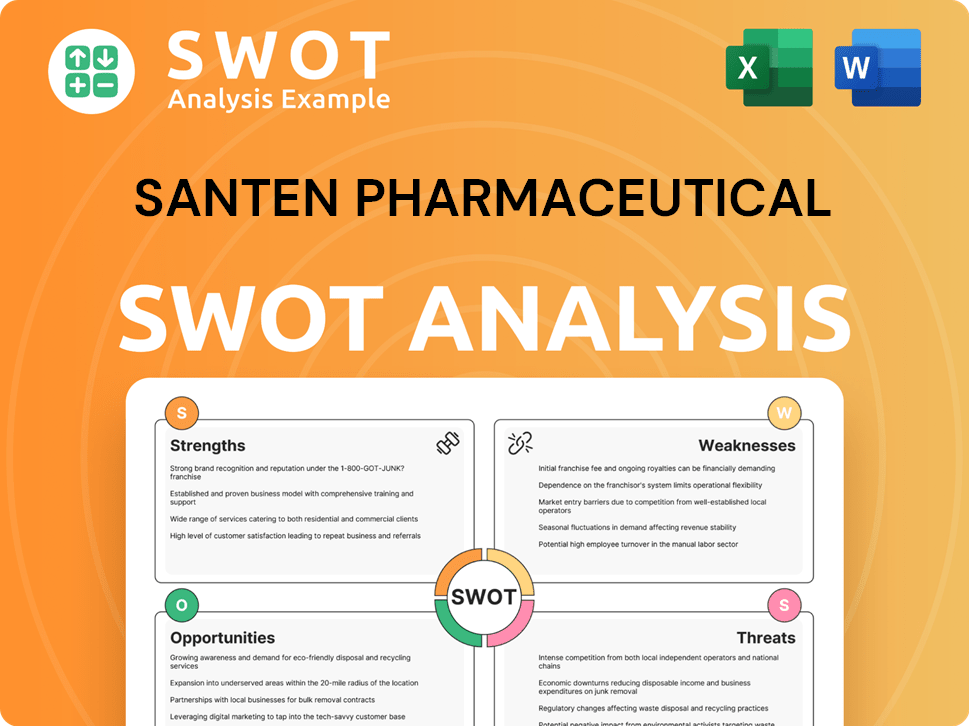
How Has Santen Pharmaceutical’s Ownership Changed Over Time?
The ownership structure of Santen Pharmaceutical has evolved since its initial public offering (IPO) on April 20, 1964. As a publicly traded entity listed on the Tokyo Stock Exchange (TYO: 4536), the company's ownership is primarily influenced by institutional investors. This structure has seen shifts over time, reflecting the dynamic nature of investment in the pharmaceutical industry and the strategic decisions of major shareholders.
The company's shareholding composition has been shaped by various factors, including market performance, strategic investments, and broader economic trends. The presence of significant institutional investors like trust banks and asset management firms underscores the company's appeal to a diverse range of financial entities. These entities often engage with the company's management, influencing strategic decisions and corporate governance practices.
| Shareholder | Shares Held (approximate) | Percentage of Investment (as of March 2025) |
|---|---|---|
| The Master Trust Bank of Japan, Ltd. (Trust Account) | 58,076 thousand | 16.97% |
| Custody Bank of Japan, Ltd. (Trust Account) | 18,594 thousand | 5.43% |
| BNYM AS AGT/CLTS NON TREATY JASDEC | 10,857 thousand | 3.17% |
| Nippon Life Insurance Company | 10,662 thousand | 3.11% |
| NORTHERN TRUST CO. (AVFC) RE SILCHESTER INTERNATIONAL INVESTORS INTERNATIONAL VALUE EQUITY TRUST | 10,567 thousand | 3.08% |
As of March 2025, Santen had 342,055,554 issued shares and 24,124 shareholders. Key institutional holders include The Master Trust Bank of Japan, Ltd., Custody Bank of Japan, Ltd., and others, as of March 2025. Other significant shareholders include Silchester International Investors, L.L.P. (6.08% as of February 2025), and BlackRock, Inc. (5.35% as of November 2024). These holdings reflect the ongoing interest and investment in Santen Pharmaceutical, influencing the company's strategic direction and financial performance.
Santen Pharmaceutical's ownership structure is primarily characterized by institutional investors, with major shareholders including trust banks, asset management firms, and insurance companies.
- The Master Trust Bank of Japan, Ltd. is a significant shareholder, holding a substantial percentage of the company's shares.
- Other key institutional investors include Custody Bank of Japan, Ltd., and various asset management companies.
- These major shareholders influence the company's strategy and financial performance through their investment decisions and engagement with management.
Santen Pharmaceutical PESTLE Analysis
- Covers All 6 PESTLE Categories
- No Research Needed – Save Hours of Work
- Built by Experts, Trusted by Consultants
- Instant Download, Ready to Use
- 100% Editable, Fully Customizable
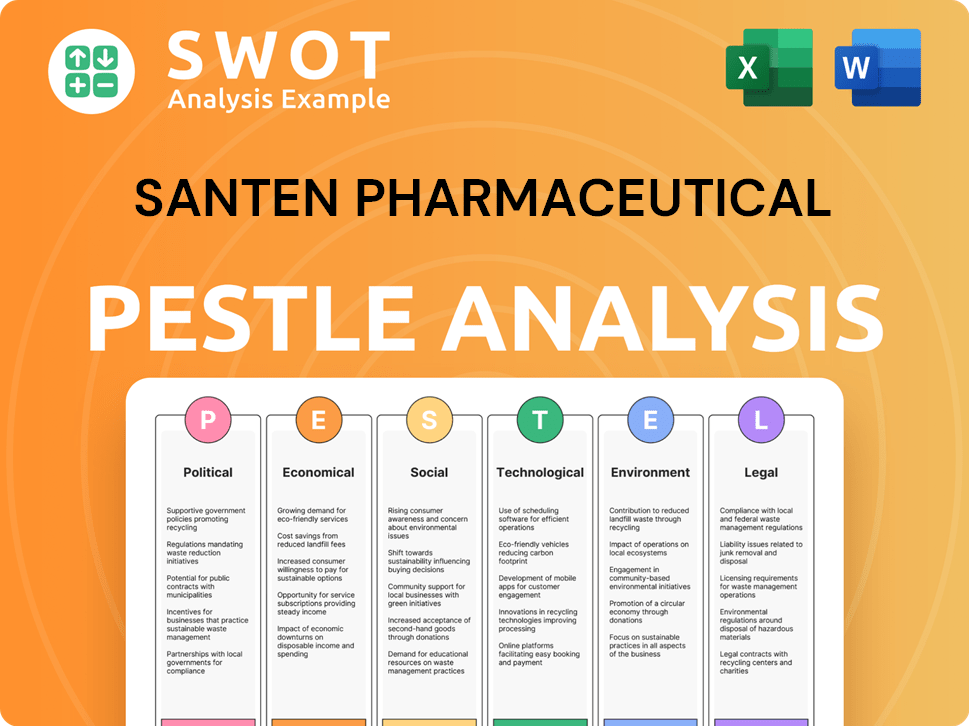
Who Sits on Santen Pharmaceutical’s Board?
As of June 25, 2024, the Board of Directors of Santen Pharmaceutical includes a mix of internal and independent outside directors. Takeshi Ito holds the positions of Representative Director, President, and Chief Executive Officer. Akira Kurokawa serves as the Director of the Board and Chairman. This structure ensures a balance of operational expertise and independent oversight, crucial for effective corporate governance within the Growth Strategy of Santen Pharmaceutical.
The board comprises several key members, including both executive and non-executive directors. The presence of outside directors, designated as independent officers by the Tokyo Stock Exchange, is a key feature of the governance structure. Corporate auditors also play a role in ensuring the company's financial reporting and business conduct meet regulatory standards.
| Board Member | Title | Role |
|---|---|---|
| Akira Kurokawa | Director of the Board | Chairman |
| Takeshi Ito | Representative Director | President, CEO |
| Noboru Kotani | Outside Director | Member of the Board |
| Tamie Minami | Outside Director | Member of the Board |
| Rie Nakajima | Member of the Board | Corporate Officer, COO, Head of China Business |
| Ippei Kurihara | Member of the Board | Corporate Officer, Head of Japan Business, Global Commercial Strategy |
| Masahiko Ikaga | Member of the Board | Previously Corporate Auditor |
| Minoru Kikuoka | Member of the Board | Member of the Board |
Santen Pharmaceutical's voting structure adheres to a one-share-one-vote principle, which is standard for publicly traded companies in Japan. Shareholders can cast their votes online or in writing, particularly during annual general meetings. The company's governance framework emphasizes transparency and collaboration, with independent outside directors and corporate auditors regularly exchanging information to ensure proper business practices. There have been no significant proxy battles or activist investor campaigns that have substantially altered the company's decision-making in recent years. The company's commitment to these practices reflects a focus on maintaining shareholder value and upholding high standards of corporate governance within the Japanese pharmaceutical market.
Understanding the ownership structure of Santen Pharmaceutical is key for investors. The company's governance is designed to protect shareholder interests.
- The Board includes both internal and independent directors.
- Voting rights are based on a one-share-one-vote system.
- Transparency and collaboration are key aspects of Santen's governance.
- There are no special voting rights that would grant outsized control.
Santen Pharmaceutical Business Model Canvas
- Complete 9-Block Business Model Canvas
- Effortlessly Communicate Your Business Strategy
- Investor-Ready BMC Format
- 100% Editable and Customizable
- Clear and Structured Layout
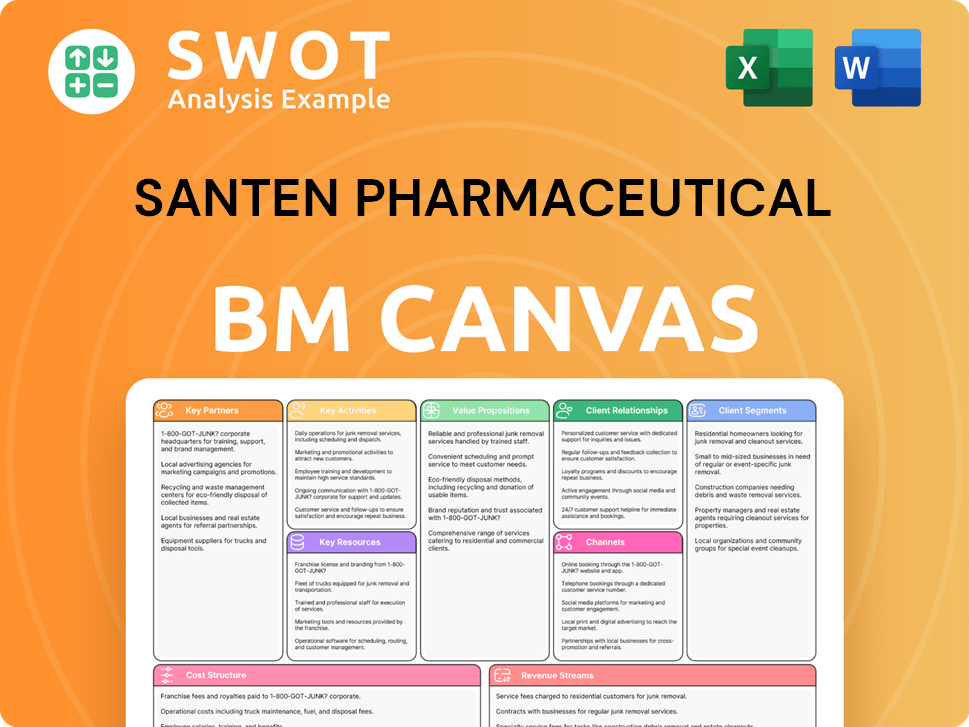
What Recent Changes Have Shaped Santen Pharmaceutical’s Ownership Landscape?
Over the past few years, Santen Pharmaceutical has demonstrated a commitment to enhancing shareholder value. This is evident through its share buyback programs. In November 2024, the company announced plans to repurchase up to 5 million shares, with a maximum value of JPY 10 billion, scheduled between November 8, 2024, and March 21, 2025. This followed a completed buyback of approximately JPY 28.6 billion. More recently, on May 13, 2025, Santen authorized a new buyback plan to repurchase up to 19,800,000 common shares, representing 5.8% of its outstanding shares, for a maximum of JPY 35 billion. This program is valid until November 5, 2025. These actions align with the company's medium-term management plan (FY2023-2025 and FY2025-2029), aiming to improve profitability and financial returns.
Leadership changes also reflect shifts within the company. Akira Kurokawa resigned as Representative Director of the Board on March 25, 2024, while remaining as Director of the Board and Chairman. Takeshi Ito assumed the roles of sole Representative Director of the Board, President, and Chief Executive Officer. This transition streamlines executive leadership. The ownership structure of the company is predominantly institutional, which is typical for a publicly traded pharmaceutical company, contrasting with its origins under founder Kenkichi Taguchi. Furthermore, strategic collaborations, like the 2013 partnership with Clearside Biomedical, Inc., highlight a dynamic approach to growth.
| Metric | Details | Date |
|---|---|---|
| Share Buyback (November 2024) | Up to 5 million shares, JPY 10 billion | November 8, 2024 - March 21, 2025 |
| Completed Buyback | Approximately JPY 28.6 billion | Prior to November 2024 |
| Share Buyback (May 2025) | Up to 19,800,000 shares, JPY 35 billion | May 13, 2025 - November 5, 2025 |
JPMorgan, in June 2025, increased its price target for Santen, pointing to the company's Q4 fiscal 2024 results and its new medium-term plan for fiscal years 2025-2029. This plan targets sales of JPY 400 billion and a core operating profit of JPY 80 billion by fiscal 2029. The share buyback program is seen as a factor likely to support the stock price. Santen's focus on new therapeutic areas, such as myopia and ptosis, as outlined in its 2024 report, indicates its strategic direction and potential for value creation, which could attract further investor interest. For those interested in a deeper dive, you can explore this article about Santen Pharmaceutical.
Akira Kurokawa's resignation as Representative Director in March 2024, with Takeshi Ito taking over as CEO, streamlining leadership.
Multiple buyback plans, including a recent one for up to JPY 35 billion, reflecting a focus on shareholder value and capital efficiency.
Predominantly institutional ownership, typical of a mature, publicly traded pharmaceutical company, with major investors.
Focus on new therapeutic areas like myopia and ptosis, signaling future strategic direction and potential for value creation.
Santen Pharmaceutical Porter's Five Forces Analysis
- Covers All 5 Competitive Forces in Detail
- Structured for Consultants, Students, and Founders
- 100% Editable in Microsoft Word & Excel
- Instant Digital Download – Use Immediately
- Compatible with Mac & PC – Fully Unlocked
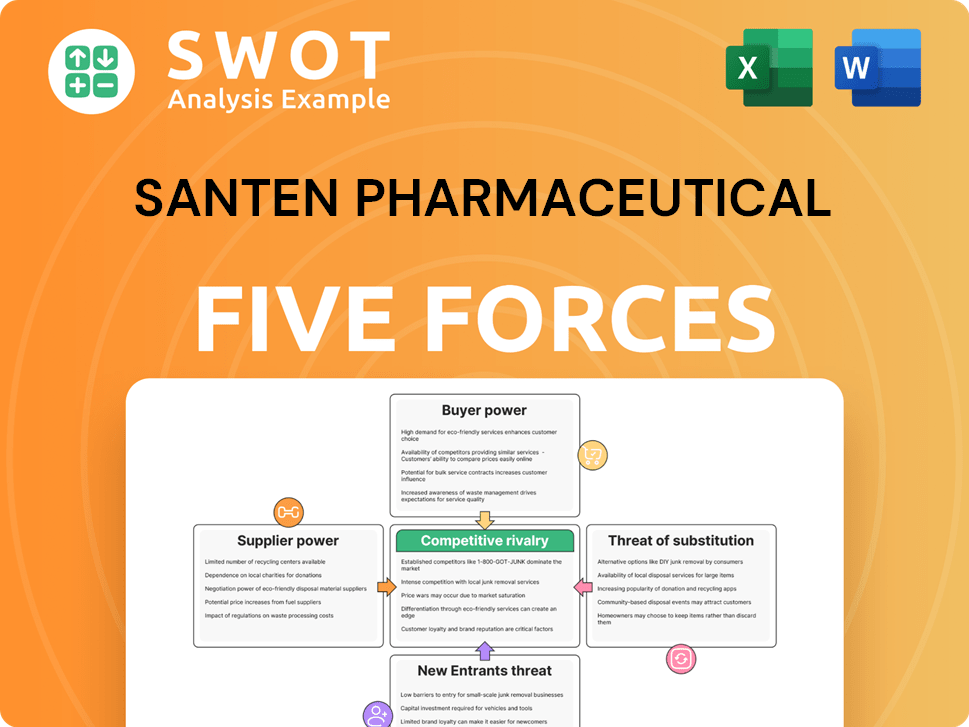
Related Blogs
- What are Mission Vision & Core Values of Santen Pharmaceutical Company?
- What is Competitive Landscape of Santen Pharmaceutical Company?
- What is Growth Strategy and Future Prospects of Santen Pharmaceutical Company?
- How Does Santen Pharmaceutical Company Work?
- What is Sales and Marketing Strategy of Santen Pharmaceutical Company?
- What is Brief History of Santen Pharmaceutical Company?
- What is Customer Demographics and Target Market of Santen Pharmaceutical Company?
Disclaimer
All information, articles, and product details provided on this website are for general informational and educational purposes only. We do not claim any ownership over, nor do we intend to infringe upon, any trademarks, copyrights, logos, brand names, or other intellectual property mentioned or depicted on this site. Such intellectual property remains the property of its respective owners, and any references here are made solely for identification or informational purposes, without implying any affiliation, endorsement, or partnership.
We make no representations or warranties, express or implied, regarding the accuracy, completeness, or suitability of any content or products presented. Nothing on this website should be construed as legal, tax, investment, financial, medical, or other professional advice. In addition, no part of this site—including articles or product references—constitutes a solicitation, recommendation, endorsement, advertisement, or offer to buy or sell any securities, franchises, or other financial instruments, particularly in jurisdictions where such activity would be unlawful.
All content is of a general nature and may not address the specific circumstances of any individual or entity. It is not a substitute for professional advice or services. Any actions you take based on the information provided here are strictly at your own risk. You accept full responsibility for any decisions or outcomes arising from your use of this website and agree to release us from any liability in connection with your use of, or reliance upon, the content or products found herein.